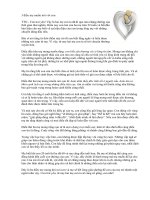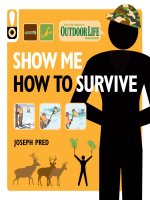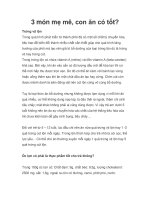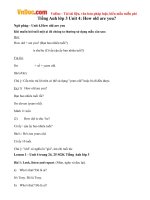3 3 3 follow me how people track animals (life science)
Bạn đang xem bản rút gọn của tài liệu. Xem và tải ngay bản đầy đủ của tài liệu tại đây (4.07 MB, 14 trang )
Suggested levels for Guided Reading, DRA,™
Lexile,® and Reading Recovery™ are provided
in the Pearson Scott Foresman Leveling Guide.
Life Science
Follow Me!
How People Track Animals
Genre
Expository
nonfiction
Comprehension
Skills and Strategy
• Draw Conclusions
• Compare and
Contrast
• Ask Questions
Text Features
•
•
•
•
Captions
Diagram
Maps
Glossary
Scott Foresman Reading Street 3.3.3
by Donna Watson
ISBN 0-328-13360-4
ì<(sk$m)=bd gae< +^-Ä-U-Ä-U
Reader Response
1. If you found a small bird with a silver band
around one leg, what would you conclude
about this animal?
2. You are going to try to track bats. What
questions do you have about tracking
bats? Use a graphic organizer like the one
below to arrange your questions.
Follow Me!
How People Track Animals
What We
W ant to Know
by Donna Watson
3. The phrase “microchip transmitter” is
found on page 17. Do you know what that
means? How might you be able to figure
out the meaning of the phrase if you
don’t already know it?
4. Turn to pages 10–11. How does the
diagram help you understand GPS tracking?
Editorial Offices: Glenview, Illinois • Parsippany, New Jersey • New York, New York
Sales Offices: Needham, Massachusetts • Duluth, Georgia • Glenview, Illinois
Coppell, Texas • Ontario, California • Mesa, Arizona
Every effort has been made to secure permission and provide appropriate credit for
photographic material. The publisher deeply regrets any omission and pledges to
correct errors called to its attention in subsequent editions.
Getting On Track
People have tracked animals in the wild for
thousands of years. In the past, people tracked
animals and studied their habits in order to
hunt them. More recently, people have tracked
wildlife in order to help endangered animals.
Wildlife biologists, who study living things,
follow and watch animals to record and study
data, or information, about them.
The easiest way for biologists to find animals
is to follow their footprints. This works in mud,
snow, or wet sand. But what about animals that
spend their entire lives in the water or in the
air, never touching the ground? Obviously they
don’t leave footprints! Luckily there are many
other ways to find animals.
Unless otherwise acknowledged, all photographs are the property of Scott Foresman,
a division of Pearson Education.
Photo locators denoted as follows: Top (T), Center (C), Bottom (B), Left (L), Right (R),
Background (Bkgd)
Opener: AP/Wide World Photos; 3 ©DK Images; 4 Getty Images; 5 ©DK Images; 6 ©DK
Images; 7 ©DK Images; 8 Wilburn, Jack/Animals Animals/Earth Scenes; 10 (CL) ©DK
Images, (BC) Getty Images, (B) Digital Wisdom, Inc.; 11 Getty Images; 12 ©DK Images;
13 Animals Animals/Earth Scenes; 14 AP/Wide World Photos; 16 ©DK Images; 18 S.J.
Krasemann/Peter Arnold, Inc.; 19 Getty Images; 20 Tony Freeman/PhotoEdit; 21 ©DK
Images; 22 Getty Images
ISBN: 0-328-13360-4
Can you see the tracks
this duck has made?
Copyright © Pearson Education, Inc.
All Rights Reserved. Printed in the United States of America. This publication is
protected by Copyright, and permission should be obtained from the publisher
prior to any prohibited reproduction, storage in a retrieval system, or transmission
in any form by any means, electronic, mechanical, photocopying, recording, or
likewise. For information regarding permission(s), write to: Permissions Department,
Scott Foresman, 1900 East Lake Avenue, Glenview, Illinois 60025.
2 3 4 5 6 7 8 9 10 V0G1 14 13 12 11 10 09 08 07 06 05
3
What if a biologist wants to investigate an
animal and can’t find any tracks? Biologists are
usually able to find other signs that an animal
has been nearby. For instance, grizzly bears rub
against trees to leave a scent. In the process,
they strip bark from the trees and leave behind
their fur. Biologists study the stripped bark,
scent, and fur to learn more about bears.
4
Like bears, male white-tailed deer also rub
against trees in order to leave a scent. Their
antlers leave marks on the trees as they rub up
against them. Porcupines eat tree bark, leaving
marks near the base of trees. Beavers take down
small trees by chewing them down to stumps.
They use the trees to build their homes, which
are called lodges. The pointed tree stumps,
lodges, and dams that beavers build help make a
beaver’s habitat easy to identify.
The diagram below shows what a typical
beaver lodge looks like. Can you see the two
entrances that the beavers have made? Biologists
can tell many things about beavers by studying
their lodges. Because of the lodges they make,
beavers are some of the easiest animals to track.
Beavers use small trees to
build lodges and dams.
5
Other Kinds of Tracks
One of the signs used to track animals is
scat, or animal droppings. Each animal’s scat
has its own color, size, and shape. Mammal
scat is the easiest to classify, or group.
Scat contains many clues that help biologists
track animals. Its location helps tell which
animal made it. Scat may also tell when the
animal was there as well as what it ate. Wolves
and coyotes usually have fur in their scat. Black
bears leave piles of scat in thick cords.
Owl pellets may look like scat, but they
aren’t. Owls swallow their prey whole. However
they cannot digest hair, feathers, or bones.
Instead of digesting them, they turn them into
pellets and cough them up. The pellets are
found at the base of trees. Pellets are one sign
biologists look for when they are tracking owls.
6
An owl pellet, which contains the
bones, hair, and feathers of its prey
The bones of small rodents, which
are one source of food for owls
7
Tracking with Radio Collars
Radio collars allow biologists to track
animals from far away. To place a radio collar
around an animal’s neck, the tracker uses
special medicine, called tranquilizers, to make
the animal sleepy. Sometimes trackers are
lucky enough to find animals that are already
hibernating, or sleeping. It is much easier to
place radio collars on hibernating animals.
Biologists often put radio collars on
hibernating bears. First they locate a bear’s den.
Then they creep into the den and put a collar
around the bear’s neck while it sleeps.
Radio collars can be used to study elks’ movements.
8
Radio collar on a wolf in Yellowstone Park.
This same way of tracking can also be
used for observing eagles. Once a collar is
placed around an eagle’s leg, trackers follow
the moving bird to find out where it is nesting
and how far it must travel to get food. When
tracking smaller birds, biologists attach the radio
collar to the bird’s back. The collar fits around
the bird’s wings. Before biologists fit a collar
around a bird’s leg or back, they make sure that
the bird can fly while wearing it.
Radio collars are used to track many kinds
of animals. Nowadays there are more modern
devices that biologists use to track animals. But
radio collars still work quite well.
9
Tracking with GPS
Another way to track animals is to use a
Global Positioning System, also called GPS. A
biologist will fit an animal with a GPS collar.
The collar sends a signal that is picked up by
satellites circling Earth. The satellites use the
signals to locate the animal. Then they send
the animal’s exact location to a computer. The
biologist can check on the animal’s movement
many times during a day. Even better, collars
that use GPS can last up to two years!
Satellites like this
one send signals
to GPS devices.
GPS collars
attached to
bears send
signals to
satellites.
10
GPS is an excellent way for biologists to
study an animal’s travel patterns. It can also be
used to take a measurement of an animal’s
hunting range. GPS provides regular, detailed
data on an animal’s location. However, GPS
collars are heavier than radio collars. Also,
GPS information shows up only as a dot on
a computer screen. Because of that, biologists
who use GPS collars don’t get to view the
animal they are studying.
GPS devices
receive signals
from satellites.
Biologists use
GPS signals
to track the
bears.
11
Tracking Cranes in Planes
Both radio and GPS collars have been used
to help save the whooping crane. Hunting and
loss of habitat had reduced the whooping crane
population to about twenty birds. In order to
save these animals, biologists started raising
whooping cranes in captivity. They hoped that
it would only take a short period of time to get
the young cranes ready for release into the wild.
Both GPS and radio collars have
helped save whooping cranes.
Sometimes chicks have difficulty migrating.
There was only one problem: The crane
chicks did not know that they were supposed
to move south, or migrate, for the winter.
Biologists had to teach the whooping cranes to
fly from Wisconsin to Florida. The biologists
decided that the best way to do this would be if
they dressed up as birds! The whooping cranes
had radio and GPS collars placed around their
legs. They were trained to follow an airplane
flown by pilots wearing crane costumes. As
you’ll read, this idea ran into difficulties. Overall,
though, the experiment was a great success.
12
13
From the start, the whooping cranes were
able to follow the plane. Their migration took
longer than normal because the airplane had
to fly low in the sky. That forced the birds to
flap their wings more often. The airplane also
put the cranes at risk by leading them close to
power lines and other dangerous things.
Biologists taught whooping cranes
to migrate by flying in planes.
Using the radio collars, biologists were able
to find whooping cranes that had been blown
off course or become lost. Once the birds
arrived safely in Florida, they spent the winter
with other whooping cranes. In the spring,
they migrated back to Wisconsin on their own,
without the help of the plane. The biologists
tracked the whooping cranes’ flight back to
Wisconsin by monitoring their GPS collars.
The path the whooping cranes migrated
from Wisconsin to Florida and back.
14
15
Tracking Blue Whales
Another special type of satellite tracking
has been used to study blue whales. These
whales usually travel in groups, with two to
four whales in each group. Biologists wanted to
know where the whales liked to search for food
and where they migrated to each year. By using
a special crossbow, they were able to attach
satellite transmitters to about one hundred
whales. The satellite transmitters have provided
new information for biologists to record and
analyze, or examine carefully.
Biologists have learned about blue whales through
satellite tracking.
16
The transmitters that were attached to
the blue whales had to work successfully with
the largest animals in the world! With smaller
animals, biologists have to use other kinds of
tracking devices. Microchip transmitters are
one such kind of tracking device. They work
very well with small animals such as snakes. A
biologist will take a microchip transmitter and
place it under a snake’s skin. The transmitter
will not harm the snake at all while it’s attached.
Microchip transmitters have helped
biologists understand the mating, hunting, and
hibernating habits of snakes. Unfortunately,
microchip transmitters are expensive. Because
of this many scientists cannot afford to use them
while they are studying animals.
Microchip transmitters cause other
problems. Although they are the safest type of
tracking devices, it can be difficult to place them
under the skin of the animal being tracked.
17
Tracking Through Tag-and-Release
Another method of tracking that has been
used for fish, amphibians, birds, and mammals
is the tag-and-release method. Here’s how it
works: Biologists catch an animal like a red wolf.
They mark it with a special tag. The wolf is then
returned to the wild. Biologists try to recapture
the wolf later on at a different location.
Tag-and-release is risky. The biologists might
not be able to recapture the wolf later on!
Park rangers and biologists attach a
radio collar to a red wolf. The wolf is
being readied for release into the wild.
Biologists also use tag-and-release with
birds. They place special nets, called mist
nets, between trees. Birds fly into the nets and
become stuck. The biologists remove the birds
from the nets. Then they measure the birds and
tag their legs or backs with small metal bands.
The bands’ identification numbers help
the biologists tell the birds apart. A telephone
number may also be listed on each band. That
way, if the bird is recaptured, the biologist
conducting the study can be notified. Tag-andrelease helps biologists record information about
where birds travel and how long they live.
Eagles like this one
can be tracked with
leg bands.
18
19
Tracking Animals at Night
Just like with birds, biologists also use mist
nets to catch bats. Since bats are most active at
night, biologists attach glow sticks to their backs
before they release them back into the wild.
The glow sticks allow biologists to follow
the bats back to their home. The sticks
also allow biologists to follow the bats if
they go hunting. The sticks only last a few hours.
However, they provide a great source of light.
Another method for tracking animals at
night uses black light. Once a small animal is
caught, a fine powder is dusted all over its body.
When the animal is released, the powder falls
along the ground. This leaves a trail that can be
followed using a special black light.
20
Amazingly, biologists have even found ways
to track insects! They use the same instrument
that other scientists use to forecast weather—
Doppler radar. This radar allows biologists to
find large groups of migrating insects. Thanks to
radar tracking, farmers can be warned in time to
protect their crops from hungry bugs.
Tracking is just one way biologists learn
more about animals. Analyzing scat, examining
habitats, and attaching collars to animals are all
useful tracking methods. Biologists use these
methods to collect important information.
Animal tracking is a fascinating way to learn
more about animals and the world around us!
21
Now Try This
Find Out About Wildlife Biologists
Have you ever wondered what it is like to be
a wildlife biologist? With this activity, you’ll be
able to find out!
22
to Do It!
w
o
H
s
’
e
r
He
First, investigate what type of education is
necessary. Use the Internet, your school library,
and other sources to answer the following
questions: How many years of study are
required? What classes must students take to
become wildlife biologists? Do they have to pass
any special tests? What schools are considered
the best for training students to become wildlife
biologists? How has the job of being a wildlife
biologist changed over the years?
After you have found out about the
careers of some wildlife biologists, write a brief
summary of them. In small groups, compare
your summary with those of other classmates.
Does being a wildlife biologist sound like an
attractive career to you? Why or why not?
Discuss these questions with your group.
23
Reader Response
Glossary
analyze v. to
examine carefully
and in detail.
biologists n. people
who study living
things.
classify v. to arrange
in classes or groups;
group according to
some system.
data n. facts from
which conclusions
can be drawn;
information.
hibernating v.
spending the winter
sleeping or in an
inactive condition.
24
mammal n. any
of a great many
warm-blooded
animals with a
backbone and
usually with hair.
measurement n. size
or amount found by
measuring.
migrate v. to go
from one region
to another with
the change in the
seasons.
scat n. animal
droppings or waste.
tranquilizers n.
drugs that relax or
put animals to sleep.
1. If you found a small bird with a silver band
around one leg, what would you conclude
about this animal?
2. You are going to try to track bats. What
questions do you have about tracking
bats? Use a graphic organizer like the one
below to arrange your questions.
What We
W ant to Know
3. The phrase “microchip transmitter” is
found on page 17. Do you know what that
means? How might you be able to figure
out the meaning of the phrase if you
don’t already know it?
4. Turn to pages 10–11. How does the
diagram help you understand GPS tracking?









